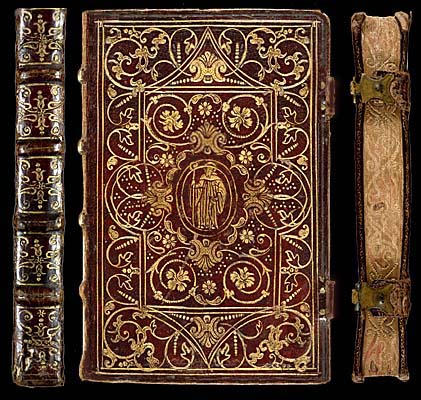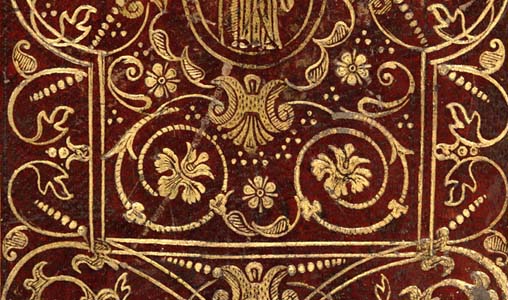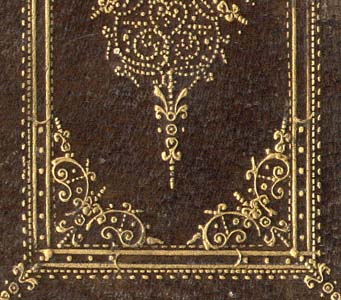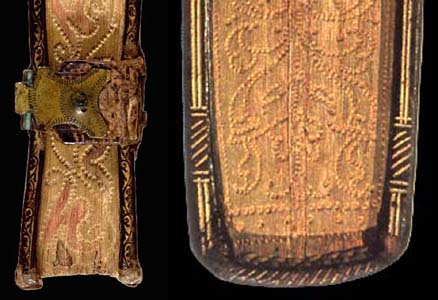

|
It is rare to find good high resolution images of Antiquarian Books online, and even if you do, they can not normally be reproduced without the concern of copyright issues. I had been hunting high and low for French Seventeenth Century Decorative bindings to continue my Breviarian research, but had found little that I could use here. Fortunately however I finally discovered the Italian Biblioteca Nazionale Braidense site. Here you will find a good collection of European Sixteenth Century bindings in high resolution images, and a note stating: "Fair use of image files of this website for non-commercial educational purposes is permitted". I have selected some bindings from that site to show what appear to be some of the earliest examples of proto Pointillé and Fanfare styles. |


| The gold tooling in these two examples is very similar in conception, although separated by more than 50 years. The Drexelius binding is thought to be of French origin and would probably be classed as true pointillé while the Italian binding of the Psalmista monasticum appears to be a sort of proto pointillé. Although pointillé is generally associated with French 17c bindings, it may be that the roots of this style go much deeper, and even possibly back into Italian bookbinding traditions. |

| I've often wondered what and where this tiny fleuron originated, what does it signify or represent, an archetypal seed pod perhaps, at any rate it has survived for centuries and is still used today. A small tool like this could hold the answer to many unknowns, we need to study its evolution into the modern form, as well as its transmission throughout Europe. |

|
Here we see that the tool has been cut so as to give a segmented line instead of a continuous solid line, this technique is the basis of pointillé tools which were to follow and dominate the styles of the following century. The site Bookbinding and the Conservation of Books A Dictionary of Descriptive Terminology gives an excellent description of the fanfare style as well as high resolution image of an early example, this same example also serves as an example in their description of .... "Gauffered Edges ( gauffred, gaufré, goffered ) The edges of a book, usually gilded, which have been decorated further by means of heated finishing tools or rolls which indent small repeating patterns. Gauffering is most successful on a book printed on hard paper and gilt solid. It may be done directly on the gold, or by laying a different colored gold over the first, and tooling over the top gold, leaving the pattern in the new gold impressed on the original metal. The effect of gauffering is sometimes enhanced by scraping away parts of the gold and then staining the white paper showing through. While this technique was used by a number of European bookbinders, it was especially associated with German bookbinding of the 16th century. The use of color on the edges of books bound in England was less frequent and more restrained. Plain gauffering was done well into the 17th century, usually on embroidered bindings, but appears to have declined sharply after 1650 or so. It was then revived and exploited from the end of the 18th century onwards, and was especially popular in the latter half of the 19th century, when it was found on elaborately bound devotional and other books. Almost all gauffering was done with pointillé tools, or, as in many examples, the designs were built up with repeated impressions of a large dot. pointillé tools, as well as those cut in outline, produce delicate effects and are more easily impressed on a hard paper surface than are solid tools. The term comes from the French word for honeycomb, and also applies to the practice of crimping or fluting cloth with heated gauffering irons. See PLATE VI " a "fanfare style" binding in the manner of the Ève brothers on a copy of Horae beatissimae Virginis Mariae. Note the gauffered edge. Printed by Christopher Plantin, Antwerp, 1570. |

| I have reproduced here part of the PLATE VI binding compared with the 1573 Psalmista monasticum example shown above... I suggest that it's no coincidence that these two books, printed in the same decade, share the same gauffered technique which depends upon pointillé like tools, perhaps this then explains the emergence of pointillé techniques, developing from edge work and then spreading on to the leather boards. |